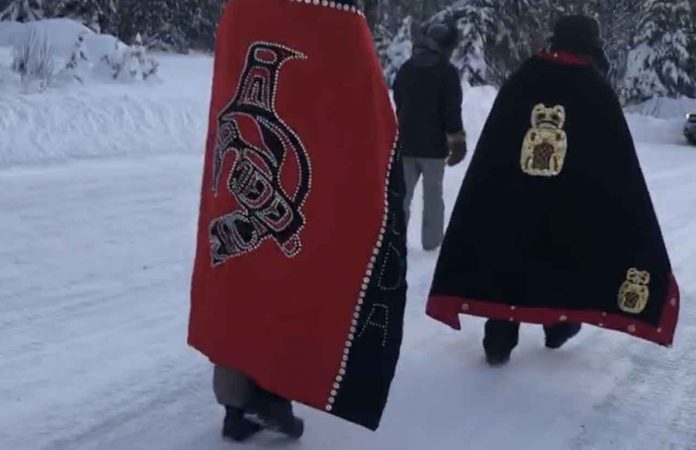WINNIPEG – More than 150 activists braved freezing temperatures to stage a round dance at Portage and Main.
They were not alone Friday January 10th. Thirty-four other, similar actions across Canada and the U.S. joined them, responding to a week-long call for solidarity from citizens of the Wet’suwet’en Nation in northwestern B.C.
For more than a year, Wet’suwet’en citizens have been standing on their own traditional territory, blocking the planned route of a natural gas pipeline owned by Coastal GasLink through their traditional territories.
They have been harassed. RCMP arrested 14 activists last January, and dismantled a camp to assist the project’s delivery.
This resulted in a now-typical Canadian cycle involving Indigenous conflict: media coverage of Indigenous arrests, national outcries, and a march to the Supreme Court over competing claims over the land, rights, and reconciliation.
The problem is actually quite simple: who speaks for the Wet’suwet’en?
The $6.2-billion pipeline has been approved by the government of Canada, the province of British Columbia, and even the elected chief and council of the Wet’suwet’en under the Indian Act — alongside all 20 of the Indian Act-elected councils along the pipeline’s route — but not by the leaders of the Wet’suwet’en traditional government.
Leaders of the Wet’suwet’en hereditary chief system, who have governed the Wet’suwet’en nation far longer than Canada has been in operation, have demanded all construction plans and permits be suspended until free, prior, and informed consent be obtained — something guaranteed to all First Nations under the constitution.
In case it’s not blatantly obvious, Indian Act governments and traditional Indigenous governments are not the same. One is an imposed system (recognized by the Canadian government) and the other is ancestral (often not recognized by Canadian officials).
Since the 1990s and the Delgamuukw case over Aboriginal title in B.C., the Wet’suwet’en have claimed nearly 22,000 square kilometres of land and never attained a resolution.
The case was thrown out in 1993 by the B.C. Appeals Court due to discrepancies regarding the use of oral tradition to claim land. A new trial was ordered. The Wet’suwet’en claim, which has not been tried since, remains in legal limbo.
For nearly four decades, the Wet’suwet’en have pursued peaceful, legal means to assert their claim. Yet, Canada, B.C., and a Canadian company is trying to take the land anyways.
When government officials can’t get one group of Indigenous leaders to agree to the project, they just find another. It’s that simple.
Spokesperson for the Wet’suwet’en hereditary chiefs, Chief Namoks (John Ridsdale), has announced: “As far as we know, Coastal GasLink intends to commit trespass on Wet’suwet’en lands and continue construction.”
On New Year’s Eve, the B.C. Supreme Court decided to grant an injunction to remove Wet’suwet’en activists from the pipeline’s route and continue construction on the route to an export facility near Kitimat.
The court essentially criminalized Indigenous citizens standing on their own lands, upholding cultural, ancestral, and customary law.
In the decision, though, is the admittance Wet’suwet’en claims remain unsolved: “The Aboriginal title claims of the Wet’suwet’en remain outstanding and have not been resolved either by litigation or negotiation, despite the urging of the Supreme Court of Canada.”
So, with legal means clearly not stopping the project’s development, what choice the Wet’suwet’en have but to fight?
On Jan. 5, the hereditary chiefs issued an eviction notice to all Coastal GasLink workers, charging them with having “bulldozed through our territories, destroyed our archaeological sites, and occupied our land with industrial man-camps… The ongoing criminalization of our laws by Canada’s courts and industrial police is an attempt at genocide.”
On Jan. 9, Coastal issued a 72-hour notice all Wet’suwet’en must leave the pipeline’s route or face arrest; RCMP added to the conflict by launching a criminal investigation into the activists.
Which brings us back to the round dance at Portage Avenue and Main Street.
Before the event began, a Winnipeg police officer appeared and warned participants the downtown intersection was too dangerous, and no one would be liable for what happened.
The dancers danced; one asked the officer if he also similarly warned Winnipeg Jets and Blue Bombers fans when they take over the space.
In the middle of the round dance, an ambulance appeared. The circle opened, allowed it through, and continued.
On a break, leaders gave a cheer for the striking workers at a nearby Tim Hortons coffee shop.
Lawful. Peaceful. Committed to good relationships and saving the Earth, alongside everyone in it — like you and me and our children.
Just like the Wet’suwet’en, facing off against forces that are anything but.
 Niigaan Sinclair
Niigaan Sinclair
Originally appeared in the Winnipeg Free Press on January 10, 2020. Republished with the permission of the author.
The views, opinions, and positions expressed by all columnists and contributors are the author’s alone. They do not inherently or expressly reflect the views, opinions and/or positions of NetNewsLedger.







